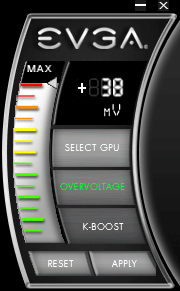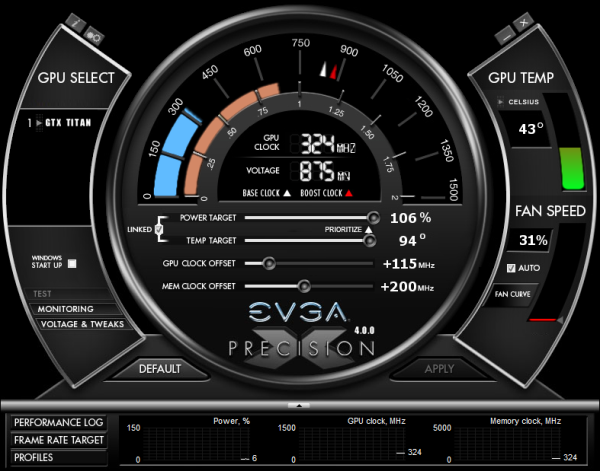NVIDIA’s GeForce GTX Titan Review, Part 2: Titan's Performance Unveiled
by Ryan Smith & Rahul Garg on February 21, 2013 9:00 AM ESTThe Final Word On Overclocking
Before we jump into our performance breakdown, I wanted to take a few minutes to write a bit of a feature follow-up to our overclocking coverage from Tuesday. Since we couldn’t reveal performance numbers at the time – and quite honestly we hadn’t even finished evaluating Titan – we couldn’t give you the complete story on Titan. So some clarification is in order.
On Tuesday we discussed how Titan reintroduces overvolting for NVIDIA products, but now with additional details from NVIDIA along with our own performance data we have the complete picture, and overclockers will want to pay close attention. NVIDIA may be reintroducing overvolting, but it may not be quite what many of us were first thinking.
First and foremost, Titan still has a hard TDP limit, just like GTX 680 cards. Titan cannot and will not cross this limit, as it’s built into the firmware of the card and essentially enforced by NVIDIA through their agreements with their partners. This TDP limit is 106% of Titan’s base TDP of 250W, or 265W. No matter what you throw at Titan or how you cool it, it will not let itself pull more than 265W sustained.
Compared to the GTX 680 this is both good news and bad news. The good news is that with NVIDIA having done away with the pesky concept of target power versus TDP, the entire process is much simpler; the power target will tell you exactly what the card will pull up to on a percentage basis, with no need to know about their separate power targets or their importance. Furthermore with the ability to focus just on just TDP, NVIDIA didn’t set their power limits on Titan nearly as conservatively as they did on GTX 680.
The bad news is that while GTX 680 shipped with a max power target of 132%, Titan is again only 106%. Once you do hit that TDP limit you only have 6% (15W) more to go, and that’s it. Titan essentially has more headroom out of the box, but it will have less headroom for making adjustments. So hardcore overclockers dreaming of slamming 400W through Titan will come away disappointed, though it goes without saying that Titan’s power delivery system was never designed for that in the first place. All indications are that NVIDIA built Titan’s power delivery system for around 265W, and that’s exactly what buyers will get.
Second, let’s talk about overvolting. What we didn’t realize on Tuesday but realize now is that overvolting as implemented in Titan is not overvolting in the traditional sense, and practically speaking I doubt too many hardcore overclockers will even recognize it as overvolting. What we mean by this is that overvolting was not implemented as a direct control system as it was on past generation cards, or even the NVIDIA-nixed cards like the MSI Lightning or EVGA Classified.
Overvolting is instead a set of two additional turbo clock bins, above and beyond Titan’s default top bin. On our sample the top bin is 1.1625v, which corresponds to a 992MHz core clock. Overvolting Titan to 1.2 means unlocking two more bins: 1006MHz @ 1.175v, and 1019MHz @ 1.2v. Or put another way, overvolting on Titan involves unlocking only another 27MHz in performance.

These two bins are in the strictest sense overvolting – NVIDIA doesn’t believe voltages over 1.1625v on Titan will meet their longevity standards, so using them is still very much going to reduce the lifespan of a Titan card – but it’s probably not the kind of direct control overvolting hardcore overclockers were expecting. The end result is that with Titan there’s simply no option to slap on another 0.05v – 0.1v in order to squeak out another 100MHz or so. You can trade longevity for the potential to get another 27MHz, but that’s it.
Ultimately, this means that overvolting as implemented on Titan cannot be used to improve the clockspeeds attainable through the use of the offset clock functionality NVIDIA provides. In the case of our sample it peters out after +115MHz offset without overvolting, and it peters out after +115MHz offset with overvolting. The only difference is that we gain access to a further 27MHz when we have the thermal and power headroom available to hit the necessary bins.
| GeForce GTX Titan Clockspeed Bins | |||
| Clockspeed | Voltage | ||
| 1019MHz | 1.2v | ||
| 1006MHz | 1.175v | ||
| 992MHz | 1.1625v | ||
| 979MHz | 1.15v | ||
| 966MHz | 1.137v | ||
| 953MHz | 1.125v | ||
| 940MHz | 1.112v | ||
| 927MHz | 1.1v | ||
| 914MHz | 1.087v | ||
| 901MHz | 1.075v | ||
| 888MHz | 1.062v | ||
| 875MHz | 1.05v | ||
| 862MHz | 1.037v | ||
| 849MHz | 1.025v | ||
| 836MHz | 1.012v | ||
Finally, as with the GTX 680 and GTX 690, NVIDIA will be keeping tight control over what Asus, EVGA, and their other partners release. Those partners will have the option to release Titan cards with factory overclocks and Titan cards with different coolers (i.e. water blocks), but they won’t be able to expose direct voltage control or ship parts with higher voltages. Nor for that matter will they be able to create Titan cards with significantly different designs (i.e. more VRM phases); every Titan card will be a variant on the reference design.
This is essentially no different than how the GTX 690 was handled, but I think it’s something that’s important to note before anyone with dreams of big overclocks throws down $999 on a Titan card. To be clear, GPU Boost 2.0 is a significant improvement in the entire power/thermal management process compared to GPU Boost 1.0, and this kind of control means that no one needs to be concerned with blowing up their video card (accidentally or otherwise), but it’s a system that comes with gains and losses. So overclockers will want to pay close attention to what they’re getting into with GPU Boost 2.0 and Titan, and what they can and cannot do with the card.











337 Comments
View All Comments
Alucard291 - Friday, March 8, 2013 - link
And once again you spew your b/s out of every orifice.But you still haven't said why you think your walls of nonsense make any difference :)
To 4chan with ya
CeriseCogburn - Sunday, February 24, 2013 - link
You people literally are pathetic. Right now, the cheapest gtx 670 is $720 sli, right ?Get your sli motherboard, get ready for extra heat, a better PS ( already stated botiques are launching these with 450W PS.
So how many months after 670 launch with reduced prices are you only 25% off the single fastest video card in the world, while you take the cheapest version you can find ?
You people are seriously filling your diapers at an unbelievable rate.
I'll note once again for all you fools who continuously missed it, and still do, because of course, your gigantic flapping lips wraped around the gourd so many times they sealed off oxygen flow to the brain that you not only don't want to face reality, but choose not to on purpose:
There was a manufacturing shortage for die space in Jan 2012 when 79xx did a near paper launch. Availability for that card was short till a day before the small in comparison 680 die hit the shelves far over half a year later, and the SINGLE factory in the entire world for production was busily building out well over 2 BILLION in emergency production space desperately trying to keep up with bare minimum demands.
THERE WAS NO CAPACITY to produce a 7.1B transistor chip. The design of the chips follows a very slow SEVERAL YEAR slog, and even now, yield on the most complex chip ever is no doubt too low for comfort, and far too low to have been "launched" WHEN YOU IDIOT TIN FOIL HAT WEARING CHARLIE D BUTT KISSING MIND SLAVE FOOLS claim the conspiracy against all gamers was undertaken by "the greedy nVidia".
You people suck.
ronin22 - Thursday, February 21, 2013 - link
Common, stupid..If you are expecting a gaming card, go buy your AMD whatever.
The real magic of Titan is its compute power.
You were stupid to expect anything else from a GK110
CeriseCogburn - Saturday, February 23, 2013 - link
Good to know amd absolutely failed to produce a top end videocard and has stuck all you tards with their only release, a mid range, at $579+ in comparison.
Be a mid ranger, buy amds flagship, the half mast loser card mid range.
piiman - Saturday, February 23, 2013 - link
Come on it's priced , for now, for the Geeks that have to have the biggest most bad ass card out. It will come down once those suckers...oops I mean enthusiast are sucked dry. :-)CeriseCogburn - Saturday, February 23, 2013 - link
Since amd is a sucked dry shriveling corpse (excellent fanboy mistreatment by the tightwad whining poorboy amd penny pinching freaks), your theory, if we give a single deformed brain cell of credit to the amd fanboys, when they wail without amd everything will be a thousand bucks, may not pan out.AMD is dying, and when gone, a thousand bucks will be standard, right all you amd fanboys ?
Start getting used to it.
L O L
atlr - Thursday, February 21, 2013 - link
Agreed. I was hoping for an initial price somewhat proportional to the performance like US$700. Perhaps ebay will be flooded with enough 680's and 690's from the early 'ticket' buyers which will cause retail prices of the same to drop.wongwarren - Thursday, February 21, 2013 - link
Guess you guys didn't read the article properly:With a price of $999 Titan is decided out of the price/performance race; Titan will be a luxury product, geared towards a mix of low-end compute customers and ultra-enthusiasts who can justify buying a luxury product to get their hands on a GK110 video card.
Alucard291 - Thursday, February 21, 2013 - link
Wait wait wait, a GPU is now a luxury product?There was me thinking that all pc components have long since become commodities...
JeffFlanagan - Thursday, February 21, 2013 - link
I agree that talk of a luxury GPU seems odd. Is there any game that will actually look better with this card rather than a $400 card?It may allow the user to up the resolution, but is anyone even shipping textures with detail beyond 1080p these days?
I haven't bought a video card in several years, and can still select Ultra settings on new games at 1080p.